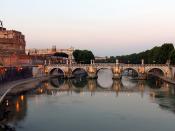Roman Baths
People today think of bathing as a private activity, while Romans usually bathed in public facilities that in some ways resemble modern spas or health clubs. Roman baths were generally used for entertainment, healing, or to just simply get clean. There were 170 baths in ROme during Octavius' reign and by 300 A.D. that number had increased to over 900 baths.
The baths were vast buildings built at either public expense or by rich emperors who wanted to impress their subjects. Occaisionally rich Romans who were trying to gain popularity would pay entry for a whole day for anyone who wished to use the baths. Small bathhouses, or balneae, might be privately owned, but in the sense that they were open to the public for a fee. Large baths, called thermae, were owned by the state and sometimes covered several city blocks. Some famous bathing houses were the Baths at Caracella, the Baths of Diocletian, and the baths at Bath.
The people who visited the baths usually stayed for several hours playing sports, bathing, and having conversations. Republican bathhouses usually had seperate bathing facilities for women and men, but the custom was to open the bathhouses to women during the early part of the day and set the afternoon till closing time (usually sundown) aside for men. Mixed bathing is generally frowned upen. Of course women who were concerned about their respectability did not frequent the baths when men were there, but the baths did provide excellant opportunities for prostitutes to practice their trade.
Upon entering the baths, people went first to the dressing room, apodyterium, where they would store their street clothes and shoes in little niches and cabinets. Bathers would sometimes bring along their slaves to carry their gear and guard their clothes in the...
![[Forum Boario, Rome, Italy] (LOC)](https://s.writework.com/uploads/17/171586/forum-boario-rome-italy-loc-thumb.jpg)


Common feature
So, what are the common features of roman baths in general?
2 out of 2 people found this comment useful.